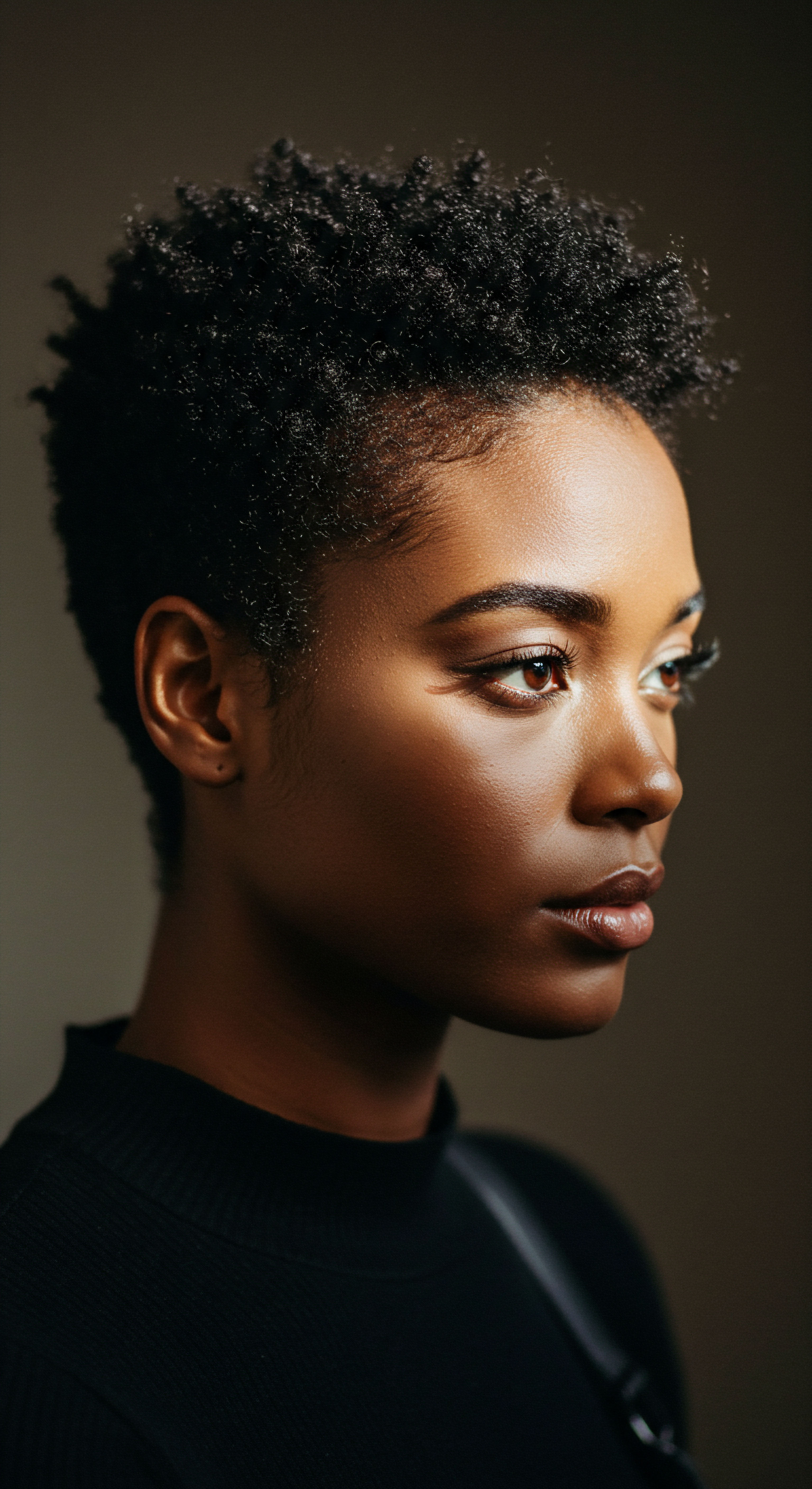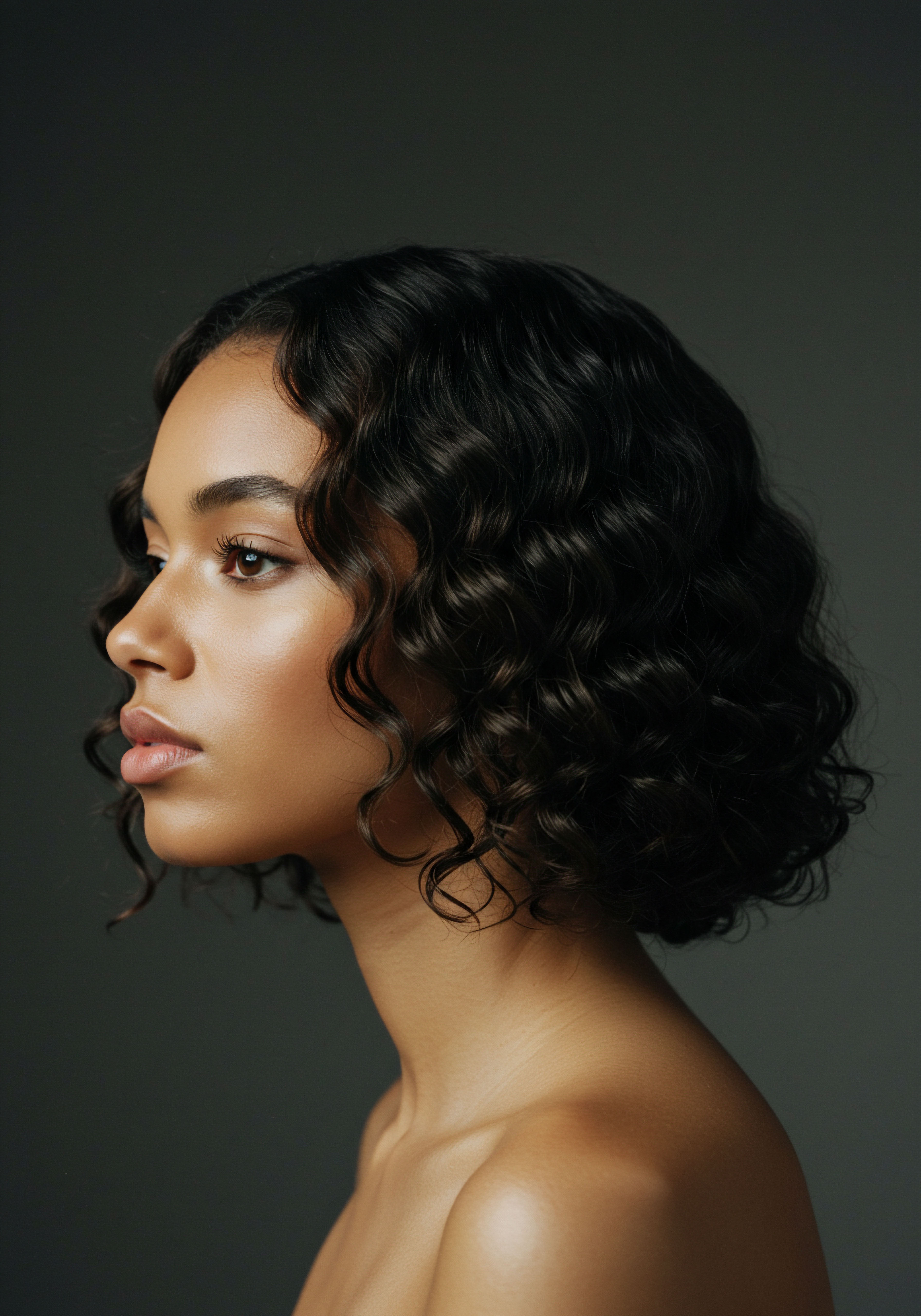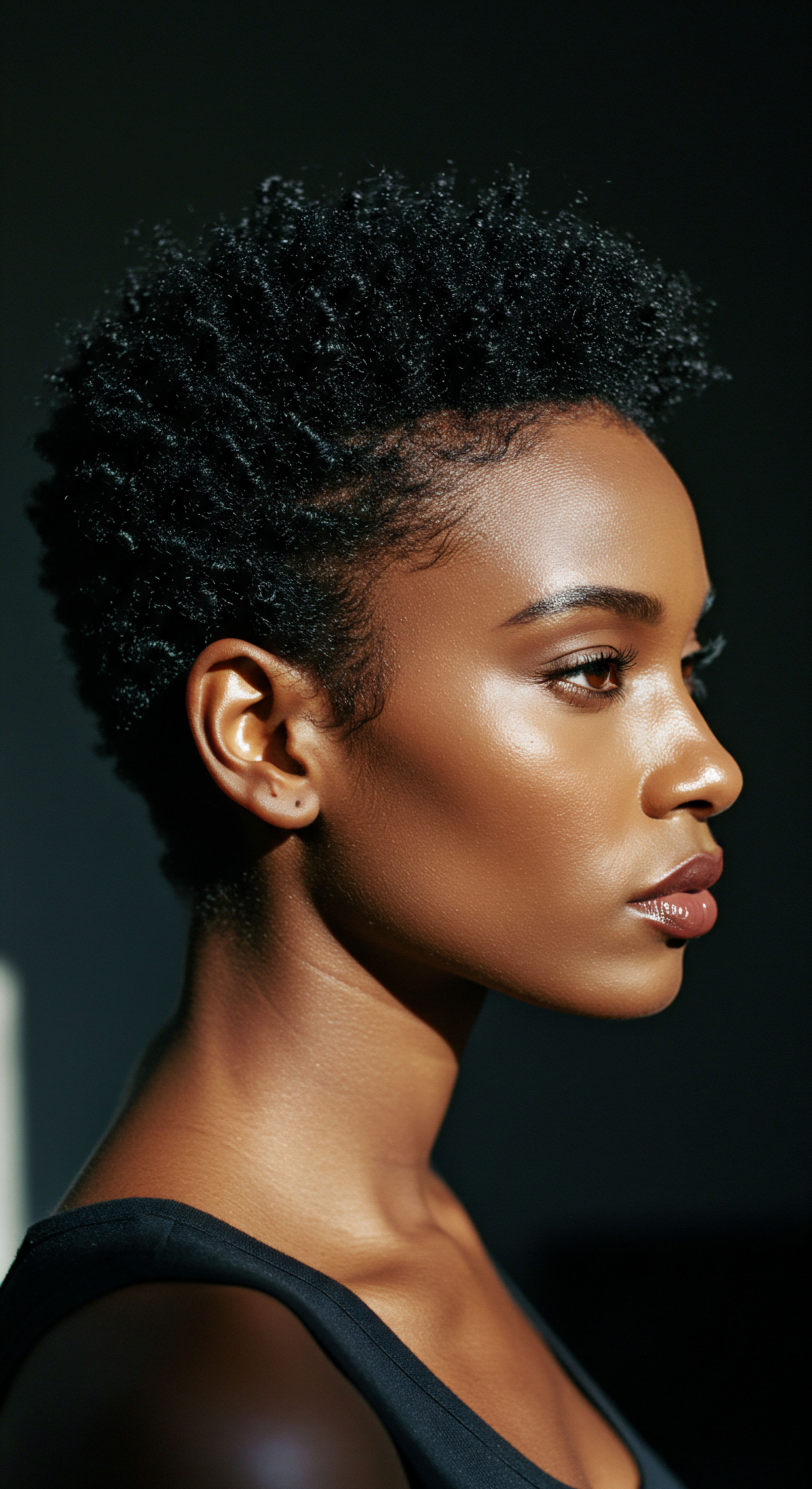
Roots
The quiet hum of the world around us, often unnoticed in its subtle shifts, continuously shapes the very essence of our being, down to the strands that crown our heads. A single hair strand, though seemingly slight, consistently meets the quiet yet forceful presence of its environment. We intuitively understand that a bright, dry day differs from a damp, cool evening, and our hair, in its own way, records these atmospheric conversations. This deep connection between the air we breathe and the hair we carry is not merely a surface observation; it descends to the fundamental structure of each strand, revealing how climate directly influences its inherent moisture.
Hair, at its core, is a remarkable protein fiber, primarily composed of keratin. This protein, arranged in intricate formations, grants hair its strength, elasticity, and unique texture. The outermost layer, known as the Cuticle, consists of overlapping, scale-like cells. These cells serve as a protective shield, guarding the inner cortex from external aggressors and regulating moisture exchange.
The cortex, beneath the cuticle, holds the majority of the hair’s mass, including its pigment, and provides its mechanical properties. Within these layers, water molecules engage in a continuous dance, held by hydrogen bonds that determine the hair’s flexibility and softness.

Hair’s Structural Blueprint and Environmental Responses
The human hair shaft is a complex biological marvel, a testament to nature’s engineering. Its distinct layers—the cuticle, cortex, and sometimes a medulla—each play a specific role in its overall health and appearance. The cuticle, like shingles on a roof, lifts or lays flat in response to its surroundings.
When these scales are tightly closed, hair feels smooth and appears shiny, effectively sealing in internal moisture. When they lift, hair can feel rougher, and moisture escapes more readily, while also allowing external moisture to enter.
Environmental conditions act upon these structural components. Humidity, for instance, is a primary actor. When the air carries abundant water vapor, hair, being porous, absorbs this moisture. This absorption leads to the formation of additional Hydrogen Bonds within the keratin proteins, causing the hair shaft to swell.
This swelling can lift the cuticle, leading to a textured surface that often appears as frizz. Conversely, in dry environments, hair releases its internal moisture to the parched air, leading to dehydration, brittleness, and an increased likelihood of breakage.
Hair, a protein fiber, responds to its surroundings by adjusting its moisture content, a process mediated by the cuticle and internal hydrogen bonds.
Beyond simple humidity, temperature also plays a significant role. Heat can cause the cuticle layers to expand and lift, making hair more susceptible to moisture loss and damage. Cold, often accompanied by low humidity, can cause the cuticle to contract, sometimes excessively, making it difficult for hair to absorb needed moisture from products. The interplay of these elements creates a dynamic environment for hair, demanding a deeper understanding of its responses.

How Does Hair’s Inner Chemistry Adapt to Climate?
The internal chemistry of hair, particularly its lipid content, also reacts to environmental cues. Lipids, though a small percentage of hair’s composition, are vital for maintaining the cuticle’s integrity and providing a barrier against moisture loss. They contribute to hair’s shine, elasticity, and tensile strength. Environmental stressors, including intense sunlight, can deplete these natural lipids, compromising the hair’s protective layer.
- Keratin Proteins ❉ The primary building blocks of hair, providing strength and elasticity, whose structure is influenced by water content.
- Cuticle Cells ❉ The outermost, overlapping scales that regulate moisture exchange, lifting in humid conditions and flattening in dry ones.
- Lipid Barrier ❉ A protective layer of natural oils that helps seal the cuticle, preventing moisture loss and defending against environmental damage.
Understanding these fundamental responses provides a groundwork for appreciating how climate impacts hair moisture. It reveals that hair is not a static entity but a responsive system, constantly seeking equilibrium with its surroundings. The moisture it holds, or loses, is a direct reflection of this ongoing environmental conversation.

Ritual
As we move from the foundational science of hair’s interaction with its environment, our focus naturally turns to the practical wisdom born from these interactions. Daily practices and periodic routines, often passed down through generations or refined through personal experience, represent our active dialogue with the climate’s influence on our hair. This section delves into how we can thoughtfully respond to environmental cues, guiding our hair toward its most vibrant state.
The art of hair care, particularly for textured strands, has always been a nuanced conversation between what nature presents and what conscious care can offer. When the air shifts, so too must our approach. A warm, humid day calls for a different regimen than a crisp, dry one, and our hair, in its delicate communication, signals these needs.

Responding to Humidity’s Dance
Humidity, that invisible cloak of moisture in the air, can be both a blessing and a challenge for textured hair. In high humidity, hair, especially porous strands, readily absorbs water from the atmosphere. While moisture is essential, an excess can lead to the cuticle swelling, causing frizz and a loss of definition. This phenomenon occurs because the hair’s keratin proteins form additional, weak hydrogen bonds with the airborne water molecules, altering the hair’s shape.
Conversely, in low humidity, hair can quickly become dehydrated, leading to dryness, brittleness, and a lack of suppleness. The air literally pulls moisture from the hair, seeking equilibrium. Our routines, therefore, must adapt to these atmospheric demands.
Adapting hair care to climate means recognizing humidity’s dual nature ❉ a source of moisture, yet also a cause of swelling and frizz when in excess.
For humid conditions, the ritual often centers on sealing the cuticle. Products containing humectants, followed by emollients and occlusives, can draw moisture into the hair while also locking it there, preventing excessive swelling. In dry climates, the focus shifts to replenishing and retaining moisture. This might involve deeper conditioning treatments, leave-in conditioners, and protective styling to minimize exposure to moisture-stripping air.

How Do Cultural Practices Guide Hair Care Through Climate?
Across diverse cultures, hair care rituals have long served as practical responses to local climates. These traditions, shaped by generations of observation and adaptation, offer profound insights into maintaining hair health amidst varying environmental conditions. For instance, communities in arid regions developed practices to seal in moisture, often relying on rich oils and butters to coat strands and prevent evaporation. In contrast, those in humid climates might have prioritized cleansing routines and lighter applications to prevent product buildup and maintain air circulation around the scalp.
Consider the use of protective styles in various climates. In hot, dry environments, styles like braids or twists can shield the hair shaft from direct sun exposure and minimize moisture loss. In humid settings, these styles can help contain frizz and maintain a desired shape without constant manipulation, which can lead to breakage. This cultural wisdom, born from living in harmony with the land, provides a rich foundation for our modern hair care approaches.
| Climate Type High Humidity Warm |
| Hair's Typical Response Frizz, swelling, loss of definition |
| Ritual Focus Sealing, defining, frizz control |
| Climate Type Low Humidity Dry |
| Hair's Typical Response Dryness, brittleness, static |
| Ritual Focus Moisture replenishment, sealing, anti-static |
| Climate Type Cold Weather |
| Hair's Typical Response Dryness, breakage, increased rigidity |
| Ritual Focus Deep conditioning, protective styles, scalp care |
| Climate Type High UV Exposure |
| Hair's Typical Response Protein degradation, color fading, dryness |
| Ritual Focus UV protection, antioxidant treatments |
| Climate Type Understanding these responses helps tailor daily hair care for optimal health. |

Crafting a Thoughtful Regimen
A thoughtful hair care regimen is not a rigid set of rules but a flexible framework, sensitive to the whispers of the weather. It involves listening to your hair, observing its behavior in different conditions, and selecting products and techniques that support its needs. This might mean rotating conditioners, adjusting the frequency of wash days, or opting for specific styling methods that counteract environmental stressors.
- Deep Conditioning ❉ Providing concentrated moisture and nutrients, especially important in dry or cold climates.
- Leave-In Treatments ❉ Offering continuous hydration and a protective barrier against environmental elements.
- Protective Styling ❉ Shielding hair from harsh conditions, reducing manipulation, and retaining moisture.
The choices we make in our hair care rituals are a dialogue with the world outside our windows. They reflect an understanding that hair is a living fiber, constantly seeking balance, and that our role is to support its resilience and vibrancy through every season.

Relay
Moving beyond daily rituals, we enter a more profound dialogue with the climate, exploring the intricate ways environmental shifts ripple through the very structure of our hair. This section endeavors to uncover the less apparent, yet deeply impactful, connections between global atmospheric patterns and the microscopic world of hair moisture. Here, science, cultural insight, and real-world data converge to illuminate a complex interplay, inviting a thoughtful consideration of our hair’s resilience in a changing world.
The relationship between climate and hair moisture extends far beyond the immediate sensations of a humid day or a dry spell. It encompasses a spectrum of influences, from atmospheric pollutants to the subtle physiological responses within the hair shaft itself, all painting a larger picture of environmental impact. Our hair, in its quiet way, acts as a barometer for these broader shifts.

The Unseen Climate ❉ Indoor Environments and Hair Moisture
While outdoor weather receives much attention, the climate within our homes and workplaces exerts a continuous, often underestimated, influence on hair moisture. Air conditioning and heating systems, while providing comfort, frequently strip the air of its humidity, creating an arid indoor environment. This sustained low humidity can lead to a constant efflux of moisture from hair, resulting in chronic dryness, increased static, and even greater susceptibility to mechanical damage.
A compelling observation from research highlights this often-overlooked aspect ❉ A study on indoor humidity and health indicated that offices in the UK frequently registered relative humidity levels as low as 25%, with some dropping to 23%—figures comparable to the Sahara Desert or California’s Death Valley. Such sustained low humidity within indoor spaces significantly contributes to issues like dry skin, flaking scalp, and brittle hair, underscoring that our hair is constantly battling the controlled, yet often dehydrating, environments we inhabit daily. This contrasts sharply with the widely recommended indoor humidity range of 40-60% relative humidity for human health and comfort. The persistent exposure to these artificially dry conditions can lead to what some might term “environmental fatigue” for hair, where the hair’s natural moisture retention mechanisms are continuously challenged.

How Do Atmospheric Pollutants Affect Hair’s Hydration?
Beyond temperature and humidity, atmospheric pollutants represent another significant, often insidious, environmental factor affecting hair health and moisture. Particulate matter, volatile organic compounds, and heavy metals, byproducts of industrial activity and vehicular emissions, can accumulate on the hair shaft and scalp. These contaminants can disrupt the hair’s surface, making it rougher and duller, which in turn compromises the cuticle’s ability to retain moisture effectively.
Research indicates that air pollution can lead to oxidative stress in hair follicle cells, and even contribute to scalp irritation and increased sebum secretion, which, counterintuitively, can weaken hair at the root, making it more prone to breakage. This indirect impact on hair moisture is particularly telling ❉ a compromised scalp environment, influenced by pollutants, can impede the hair’s natural ability to regulate its own hydration, creating a cycle of vulnerability.
| Environmental Factor Low Indoor Humidity |
| Mechanism of Impact Dehumidification by HVAC systems, water vapor removal |
| Consequences for Hair Moisture Chronic dryness, increased static, brittleness, compromised cuticle integrity |
| Environmental Factor High UV Radiation |
| Mechanism of Impact Protein degradation, lipid depletion, melanin oxidation |
| Consequences for Hair Moisture Loss of natural lipids, increased porosity, reduced moisture retention, color fading |
| Environmental Factor Air Pollution |
| Mechanism of Impact Particulate matter deposition, oxidative stress, scalp irritation |
| Consequences for Hair Moisture Rougher hair surface, compromised cuticle barrier, weakened strands, impaired natural oil balance |
| Environmental Factor Hair's response to environmental stressors is multifaceted, influencing both its structure and hydration. |

The Role of Hair Lipids in Climate Resilience
The lipid composition of hair, though a minor component by weight, is paramount to its resilience against environmental fluctuations. Ceramides, a class of lipids naturally present in the hair cuticle, serve as a vital intercellular cement, holding the cuticle cells together. When these ceramides are depleted, whether by chemical treatments or environmental stressors like UV exposure, the cuticle becomes compromised, leading to increased porosity and a diminished capacity to hold moisture.
This structural weakening makes hair more susceptible to changes in ambient humidity. Hair with a robust lipid barrier can better resist the swelling effects of high humidity and the dehydrating effects of low humidity. The presence of these protective lipids directly correlates with the hair’s ability to maintain its internal water balance, providing a scientific grounding for the emphasis on lipid-replenishing hair care.
- Ceramides ❉ Lipids that bind cuticle cells, essential for maintaining the hair’s protective barrier and preventing moisture loss.
- 18-Methyleicosanoic Acid (18-MEA) ❉ A fatty acid on the hair surface that contributes to hydrophobicity and cuticle integrity, affected by environmental damage.
- Cholesterol ❉ A lipid component within hair that contributes to its structural stability and defense against external factors.
The continuous exchange of moisture between hair and its surroundings is a dynamic process, influenced by the macro-climate and the micro-climate of our indoor spaces. Understanding these intricate relationships allows us to move beyond superficial observations, to a deeper appreciation of hair’s complex biology and its persistent efforts to maintain balance in a world of constant change. This advanced understanding empowers us to tailor our care with precision, honoring the subtle signals our hair sends in response to its environment.

Reflection
The journey through hair’s delicate dialogue with climate reveals a profound truth ❉ our strands are not merely adornments, but living indicators of the world around us. From the foundational chemistry of keratin and lipids to the nuanced responses to indoor air and unseen pollutants, hair continuously mirrors its environment. This understanding invites us to approach hair care not as a battle against the elements, but as a thoughtful partnership, a conscious effort to support its innate resilience. The wisdom gleaned from scientific inquiry, woven with the threads of ancestral practices, offers a path to truly nurture our hair, honoring its capacity to adapt and thrive amidst the world’s constant atmospheric ballet.

References
- Garner’s Garden. (2024). How Air Conditioning Affects Your Hair!
- Journal of Cosmetic Science. (2025). The Journal of Cosmetic Science Looks at Sustainability & Microbiome.
- Afterthought. (2024). How To Prevent Hair Fall Due To Air Conditioner?
- BioRoyale. (2022). How Do Air Conditioners Damage Your Hair?
- hello Jupiter. (2020). Can Air Conditioning Cause Dry Scalp?
- THE SCIENCE OF HAIR – PART TWO (Superb Chemistry ❉ Closed Cuticles, Happy Hair). (2013).
- AI Care. (2024). The Impact of Prolonged Air-Conditioning on Your Health.
- Nathalie, E. & Lee, J. V. (n.d.). Damaged hair retrieval with ceramide-rich liposomes. ResearchGate.
- Morrow, L. (n.d.). Hair Care Practices in African-American Patients.
- Sumiya, S. et al. (n.d.). Promotion of hair growth by newly synthesized ceramide mimetic compound. ResearchGate.
- NYSCC. (2021). Impact of Environmental Stressors on Hair.
- Condair. (n.d.). The importance of indoor humidification for health.
- Baazi, S. (n.d.). Nature’s Influence on Your Hair. Everand.
- Condair UK. (n.d.). Humidity and Healthcare.
- Ruetsch, S. B. et al. (2019). Ethnic hair ❉ Thermoanalytical and spectroscopic differences. Digital CSIC.
- Son, E. & Kwon, K. H. (2024). The Invisible Threat to Hair and Scalp from Air Pollution. Polish Journal of Environmental Studies.
- International Journal of Cosmetic Science. (n.d.). Ovid – Wolters Kluwer.
- Pfeiffer, C. C. (1989). Hair Analysis ❉ Applications in the Biomedical and Environmental Sciences. Vch Pub.
- Bernard, B. A. & Loussouarn, G. (2025). Hair and their environment. ResearchGate.
- Sharma, A. & Singh, N. (n.d.). The Impact of Environmental Pollution on Hair Health and Scalp Disorders.
- Gilchrest, B. A. & Yaar, M. (n.d.). The Effects of Environmental Pollutants and Exposures on Hair Follicle Pathophysiology. ResearchGate.
- Martínez-Carmona, M. et al. (2023). Hair Lipid Structure ❉ Effect of Surfactants. MDPI.
- Al-Obaidi, M. & Al-Samarai, F. (2022). Moisture in the Cuticle Sheath ❉ Effects on Hair Mechanical and Cosmetic Properties. ResearchGate.
- HowStuffWorks. (2024). Can your ethnicity affect your weather tolerance?
- Earth Endeavours. (2025). How your Hair Color can Effect Climate Change.
- Quora. (2025). How do cultural differences in hair care practices affect hair health and growth?
- Mok, L. Y. et al. (n.d.). The Genomic Variation in Textured Hair ❉ Implications in Developing a Holistic Hair Care Routine. MDPI.
- Tur, E. (2007). Environmental and Cosmetic Factors in Hair Loss and Destruction. Karger Publishers.
- International Journal of Cosmetic Science. (n.d.). Scimago.
- Reddit. (2023). Can hair acclimatize to humidity levels? Does it cause permanent damage?
- Septième. (n.d.). The Impact of Cold Weather on Your Hair.
- Al-Barami, K. & Baquir, S. (2023). Changes in traditional beautification methods as a result of climate change. ResearchGate.
- Re’equil. (2023). What are the benefits of Ceramides for skin and hair?
- Marsh, J. M. et al. (2018). Effect of humidity on photoinduced radicals in human hair. York Research Database.
- ICHIMARU PHARCOS. (2022). Published Paper – International Journal of Cosmetic Science.
- Groves, P. et al. (2018). Effect of humidity on photoinduced radicals in human hair. Free Radical Biology and Medicine.